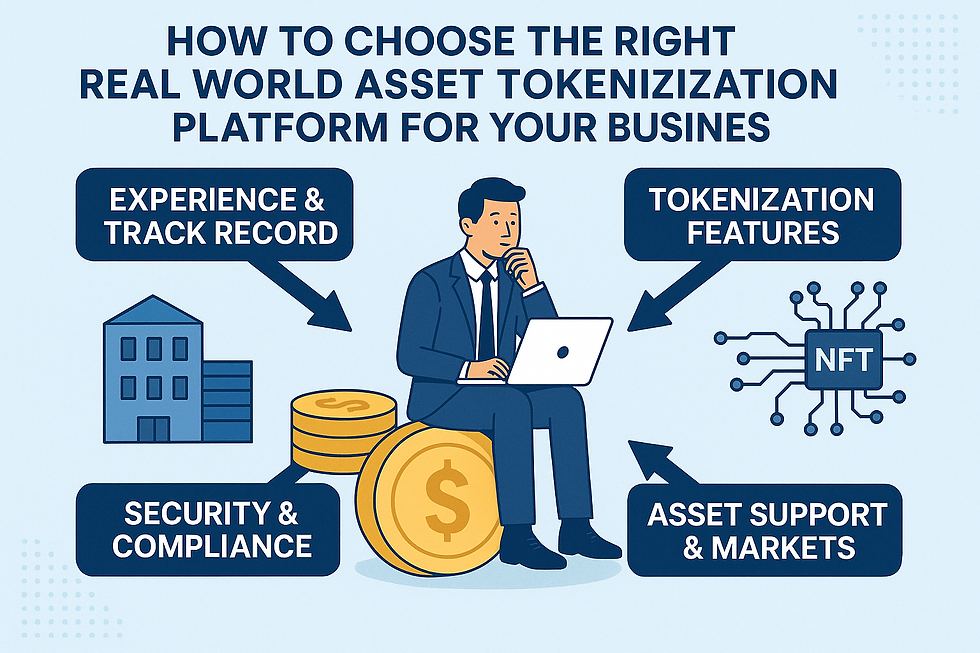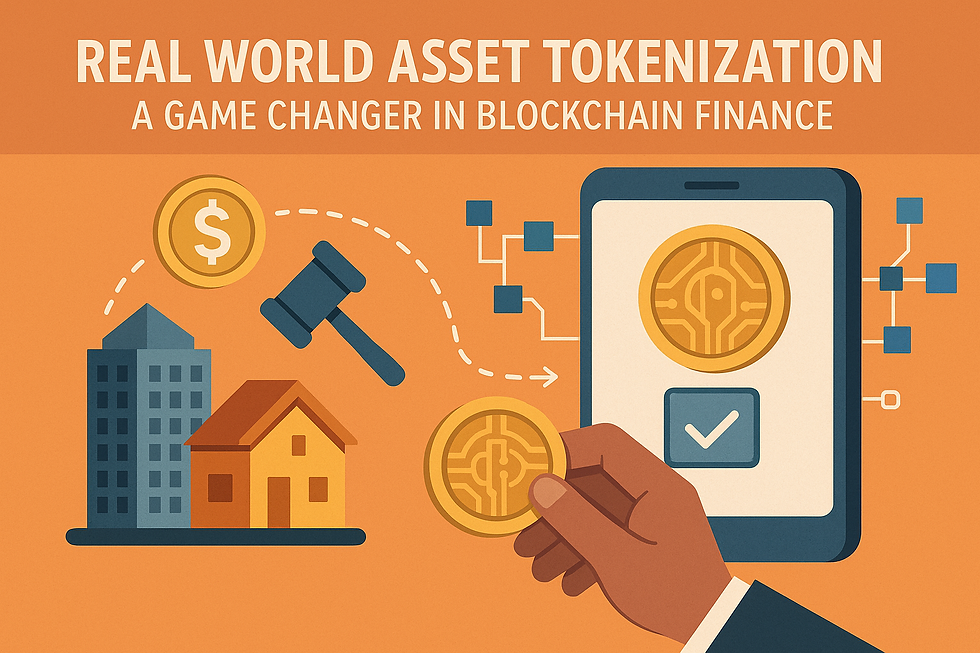Create Tokenized Real Estate Assets With Lower Costs
- steveganger
- Jul 25
- 5 min read
In recent years, Tokenized Real Estate Assets have emerged as one of the most groundbreaking innovations in real estate investing. By leveraging blockchain technology,
investors can now buy and sell fractional ownership in real estate properties globally, with unprecedented speed, security, and most importantly—lower costs.
This article explores the fundamentals of Tokenized Real Estate Assets, outlines how they drastically reduce transaction fees, and highlights their adoption across high-growth markets such as the UAE, the US, and the UK.
What Are Tokenized Real Estate Assets?
Tokenized Real Estate Assets refer to physical properties that are digitally represented on a blockchain. Each token signifies fractional ownership in a property—such as a commercial building, villa, or apartment. Unlike traditional real estate transactions that require a lengthy paper trail and high brokerage fees, tokenization offers near-instant and cost-effective transfers of ownership.
By using smart contracts, Tokenized Real Estate Assets enable transparent, tamper-proof transactions, ensuring that ownership rights and profit shares are secure and verifiable.
Why Investors Are Turning to Tokenized Real Estate Assets
Investors across the globe are seeking high-yield, stable, and low-volatility assets. Real estate has always been a solid choice, but its illiquid nature and high barriers to entry often scare away smaller investors. With Tokenized Real Estate Assets, the dynamics are shifting dramatically:
Lower Entry Costs: Investors can participate with as little as $100.
Global Access: Anyone with internet access can own property in Dubai, London, or New York.
Faster Liquidity: Investors can sell tokens on secondary markets instantly.
Reduced Operational Costs: No middlemen or heavy documentation.
These benefits have propelled Tokenized Real Estate Assets to the forefront of both retail and institutional investment strategies.
Cost Comparison: Traditional Real Estate vs. Tokenized Real Estate Assets
Traditional real estate transactions involve various intermediaries: brokers, banks, escrow agents, and legal consultants. Each of these parties takes a cut, leading to:
5–10% in broker fees
Up to 3% in legal charges
High title transfer costs
Lengthy paperwork and delays
In contrast, Tokenized Real Estate Assets slash these costs by up to 80%. With blockchain’s immutable ledger and automated smart contracts, most intermediaries become obsolete. This means:
Lower transaction costs
Instant title transfers
Reduced legal intervention
Minimal administrative overhead
As a result, creating and managing Tokenized Real Estate Assets becomes highly efficient and cost-friendly—especially for developers and property managers aiming to attract global investors.
Geographic Hotspots for Tokenized Real Estate Assets
United Arab Emirates (UAE)
Dubai is leading the charge in the adoption of Tokenized Real Estate Assets. The Dubai Land Department (DLD) has already begun initiatives to digitize land records and embrace blockchain as a service (BaaS). Several luxury villa projects and waterfront commercial towers are now open for tokenized investments.
The UAE offers:
Tax-free zones for property investors
Advanced digital infrastructure
A regulatory sandbox for blockchain innovation
For real estate developers, launching Tokenized Real Estate Assets in Dubai provides access to a rapidly growing pool of tech-savvy global investors.
United States
The US remains a hotbed for blockchain innovation. Projects in New York, Miami, and Los Angeles have begun fractionalizing luxury condos and retail buildings. Regulatory bodies like the SEC have begun providing clarity, allowing firms to register their Tokenized Real Estate Assets under frameworks such as Regulation D and Regulation A+.
This framework ensures:
Compliance with securities laws
Trust for institutional investors
High liquidity in secondary markets
United Kingdom
The UK government has also welcomed blockchain with open arms, creating a regulatory environment conducive to real estate tokenization. From London’s central flats to countryside estates, Tokenized Real Estate Assets are opening new opportunities for foreign investors without the complications of overseas banking.
How to Create Tokenized Real Estate Assets
Creating Tokenized Real Estate Assets involves several key steps, each requiring careful planning and legal oversight:
1. Property Valuation and Structuring
Before tokenization, the property must be professionally appraised. Ownership structure (SPV, REIT, or direct deed tokenization) needs to be decided, depending on legal jurisdictions.
2. Smart Contract Development
Blockchain developers write smart contracts that govern how the Tokenized Real Estate Assets are managed—dividend distribution, transfer rules, compliance verification, etc.
3. Token Issuance and Distribution
Once audited, tokens are minted and issued on a blockchain such as Ethereum, Polygon, or Solana. Investors can purchase them through:
Direct sales
Security Token Offerings (STOs)
Real estate tokenization platforms
4. Secondary Market Listing
To provide liquidity, Tokenized Real Estate Assets are often listed on licensed security token exchanges or decentralized platforms where peer-to-peer trades are permitted.
5. Compliance and KYC/AML
Investors must undergo Know Your Customer (KYC) and Anti-Money Laundering (AML) checks to meet regulatory requirements, especially in the UAE, UK, and US.
Benefits of Tokenized Real Estate Assets for Developers
For property developers and asset managers, creating Tokenized Real Estate Assets unlocks major benefits:
Global Capital Access: Attracts cross-border investments without the need for foreign bank accounts.
Faster Sales Cycles: Fractional tokens are easier to sell than whole properties.
Automated Revenue Distribution: Dividends and rental yields can be distributed via smart contracts.
Investor Transparency: Real-time reporting and blockchain records build trust.
These factors contribute to reduced marketing costs, lower holding costs, and a more streamlined capital-raising process.
Legal and Regulatory Considerations
Tokenization does not eliminate the need for compliance. Regulatory standards differ by country:
In the UAE, tokenization must align with the Virtual Assets Regulatory Authority (VARA) and Dubai Land Department regulations.
In the US, offerings of Tokenized Real Estate Assets must comply with the SEC under exemptions like Reg D or Reg A+.
In the UK, real estate token sales may fall under the Financial Conduct Authority (FCA) regulations depending on structure.
Choosing the right legal partner is critical when launching Tokenized Real Estate Assets, especially when dealing with multiple jurisdictions.
The Future Outlook of Tokenized Real Estate Assets
The global tokenized asset market is projected to reach $16 trillion by 2030, and Tokenized Real Estate Assets are expected to make up a significant portion of that. As blockchain infrastructure improves and regulatory clarity advances, the barriers to entry will continue to drop.
Here’s what the future holds:
Integration with DeFi protocols for lending and borrowing against tokenized property
Real-time property valuations using AI and oracles
Yield farming models using rental income
Global marketplaces for fractional asset exchange
In summary, Tokenized Real Estate Assets are on a clear trajectory toward mainstream adoption, driven by their cost-effectiveness, transparency, and scalability.
Final Thoughts
The opportunity to create Tokenized Real Estate Assets with lower costs is revolutionizing the global real estate market. Whether you’re a small investor looking to diversify your portfolio, or a real estate developer targeting international capital, tokenization opens doors that were previously locked.
From cutting operational expenses to enabling borderless ownership, Tokenized Real Estate Assets provide a flexible, secure, and scalable solution for the modern age. And with forward-thinking jurisdictions like the UAE, US, and UK providing regulatory support, now is the perfect time to embrace this innovative financial model.






Comments